第五讲:句法翻译
英汉句法翻译(分句、合句与长句)
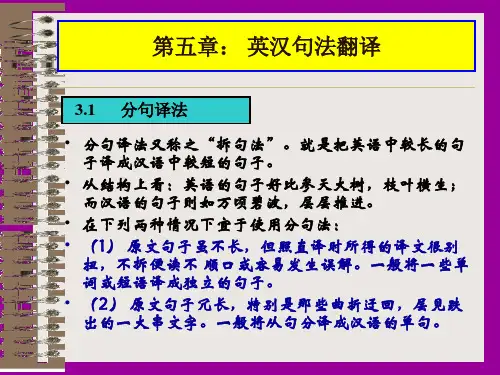
3.1 分句译法
• 分句译法又称之“拆句法”。就是把英语中较长的句 子译成汉语中较短的句子。
• 从结构上看:英语的句子好比参天大树,枝叶横生; 而汉语的句子则如万顷碧波,层层推进。
• 在下列两种情况下宜于使用分句法: • (1) 原文句子虽不长,但照直译时所得的译文很别
扭,不拆便读不 顺口或容易发生误解。一般将一些单 词或短语译成独立的句子。 • (2) 原文句子冗长,特别是那些曲折迂回,层见跌 出的一大串文字。一般将从句分译成汉语的单句。
• 4. He shook his head and his eyes were wide, then narrowed in indignation.
• 他摇了摇头,两目睁得圆圆的,接着又眯成一条线,脸 上露出了愤怒的神色。
3.1.2 将词组或短语译成汉语的句子
• 1.I wrote four books in the first three years, a record never touched before.
• 由于受到顽强抵抗,吹嘘能在几个小时内就占领要地的敌人甚 至还没有能占领外围地带,这一事实使我增强了信心。
指代它,与主句的其他 成分连句成文。
got to know the real people of Egypt.
• 英国人在埃及呆了那么多
年,却从来没有真正了解
埃及人,这是异乎寻常的。
4. It’s quite probable that he is gone.(他已经走了,有那一是条很举可世能的公。)
3.3.1 切断法(顺序法)
• 所谓切断法,就是按英语句子的语序把英语长句“化整为零”, 按意群将长句断开译成若干汉语分句。如:
汉译英:句子的翻译说课讲解
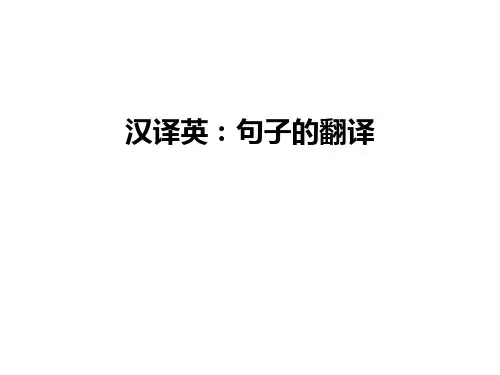
3 增补主语 :两个原则必须遵循,一是要推敲语境;二是 要考虑英语语法习惯和行文的需要。
持续下了几天雨,郊区的道路境况极坏。
The roads in the suburbs are very bad。owing to the continual rainy days.
四、翻译中的主与次
(二)汉语流水句的翻译 流水句是一种无关联词的复句,其特点是“在非终句段出现句
终语调,语义联系比较松散,句段之间难以补上关联词”(《中译 英技巧文集》第282页)。这些句子有的着重动词,即多个动词连用, 有的着重名词,即以名词为重点。例如: 紫鹃答应着,忙出来换了一个痰盆儿,将手里的这个盆儿放在 桌子上,开了套间门出来,仍旧带上门,放下撒花软帘,出来叫醒 雪雁。(《红楼梦》) 这是比较典型的流水句,事情逐一交代,层层铺开,如何英译 呢?请比较下述两种译文: 译文I:Zijuan was answering and hurried out。to change a spittoon and put the spittoon in her hand on the table and opened the door of inner room to go out,still closed it,let down the flowered portiere and went to wake Xueyan. 译文Ⅱ:Zijuan,assenting,hurried out to fetch a clean spittoon,placing the used one on the table in the outer room.Having closed the door behind her,she let down the soft flower portiere before going to wake Xueyan.(摘自杨自 俭“小议汉语几类句子的英译”)
翻译技巧:句法翻
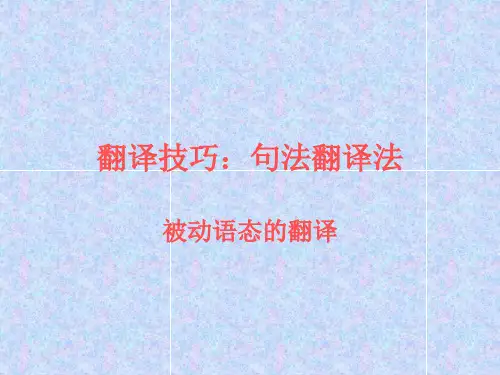
二、译成汉语无主句
• Measures have been taken to prevent the epidemic from spreading quickly. • 已经采取了措施来防止这种流行病迅速蔓延。 • Water can be shown as containing impurities. • 可以证明,水含有杂质。 • The unpleasant noise must be immediately put an end. • 必须全部停止这种讨厌的噪声。
• I finished my task just now. • My task was finished just now (by me).
• The farmers plant many apple trees there. • Many apple trees are planted there (by the farmers).
四、译成汉语被动句
• 使用“被、受、遭、让、给、由、把、得到、受到、加以、得以、 为...所、由...来”等等。 • The minister was found to have appropriated government money. • 部长被发现挪用公款。 • He had been fired for refusing to obey orders from the head office. • 他因拒绝接受总公司的命令而被解雇了。 • The schoolboy was knocked down by a minibus when crossing the street. • 那名男生在穿过街道时让一辆小公共汽车撞倒了。 • He was praised by his teacher. • 他得到了老师的表扬。 • Problems should be resolved in good time. • 问题应及时加以解决。
汉英翻译之句法篇

• 汉英翻译中的句法结构 • 汉英翻译中的句式转换 • 汉英翻译中的句子衔接 • 汉英翻译中的特殊句型 • 汉英翻译中的常见错误分析
01
汉英翻译中的句法结构
主语和谓语
主语ቤተ መጻሕፍቲ ባይዱ
表示句子中的主要对象,通常出现在句子的开始位置。在汉英翻译中,主语的 翻译需要注意保持语义的一致性,同时也要注意英语中主语的单复数和时态问 题。
无主语句
总结词
无主语句是指汉语中没有明确主语的句子, 但通过上下文或语境可以推断出主语。
详细描述
在汉英翻译中,对于无主语句的处理需要根 据英语语法规则和上下文语义进行判断,选 择适当的主语或代词来补充完整。例如,在 汉语中,“下雨了”没有明确的主语,但在 英语中需要补充主语“It”或“The rain”
谓语
表示主语的动作或状态,通常紧跟在主语之后。在汉英翻译中,谓语的翻译需 要注意保持动作或状态的一致性,同时也要注意英语中谓语的时态和语态问题。
宾语和补语
宾语
表示动作或行为的承受者,通常紧跟在谓语之后。在汉英翻译中,宾语的翻译需 要注意保持语义的一致性,同时也要注意英语中宾语的修饰关系和指代关系。
04
汉英翻译中的特殊句型
省略句
总结词
在汉语中,有时会省略句中的某些成分,使得句子结构更加紧凑,但在英语中,省略句 的使用相对较少。
详细描述
在汉英翻译中,对于省略句的处理需要根据语境和语义进行补充,以确保译文完整、准 确。例如,在汉语中,“他来了”可能省略了主语“张三”,但在英语中需要补充完整
的主语“He”。
补语
补充说明宾语的状态或特征,通常紧跟在宾语之后。在汉英翻译中,补语的翻译 需要注意保持语义的一致性,同时也要注意英语中补语的修饰关系和指代关系。
句法翻译法
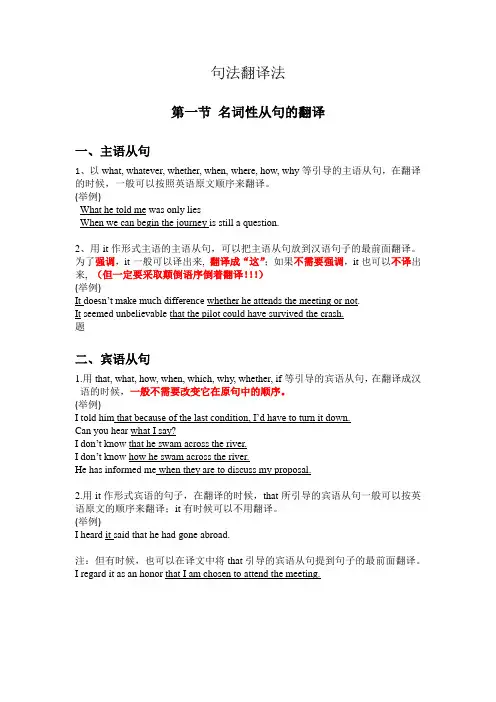
句法翻译法第一节名词性从句的翻译一、主语从句1、以what, whatever, whether, when, where, how, why等引导的主语从句,在翻译的时候,一般可以按照英语原文顺序来翻译。
(举例)What he told me was only liesWhen we can begin the journey is still a question.2、用it作形式主语的主语从句,可以把主语从句放到汉语句子的最前面翻译。
为了强调,it一般可以译出来, 翻译成“这”;如果不需要强调,it也可以不译出来, (但一定要采取颠倒语序倒着翻译!!!)(举例)It doesn’t make much difference whether he attends the meeting or not.It seemed unbelievable that the pilot could have survived the crash.题二、宾语从句1.用that, what, how, when, which, why, whether, if等引导的宾语从句,在翻译成汉语的时候,一般不需要改变它在原句中的顺序。
(举例)I told him that because of the last condition, I’d have to turn it down.Can you hear what I say?I don’t know that he swam across the river.I don’t know how he swam across the river.He has informed me when they are to discuss my proposal.2.用it作形式宾语的句子,在翻译的时候,that所引导的宾语从句一般可以按英语原文的顺序来翻译;it有时候可以不用翻译。
词法&句法翻译
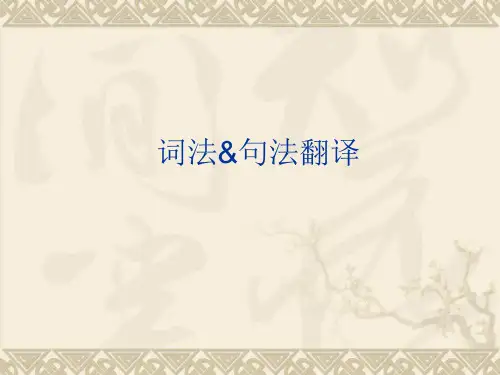
三)句子英译汉时抽象译法的译例 I was practically on my knees but he still refused. He earns scarcely enough to keep body and soul together. I have no head for music. Please don‟t wake a sleeping dog. Man for the field and woman for the hearth; Man for the sword and for the needle she. Man with the head and woman with the heart; Man to command and woman to obey. (Tennyson)
某人心肠好---------为人善良
He
has a good heart. He has a bad heart. (heart attack) 亡羊补牢 -----未为晚也 Shut the stable door after the horse has bolted (/has been stolen).-------无补于事
三)句子英译汉时具体译法的译例
All the people were exasperated by his fault-finding. 大家都被他那种吹毛 求疵的做法激怒了。 We were all greatly moved by his loftiness. 我们都被他那种崇高品质所深 深打动。 There had been too much violence in that region. 那个地区发生了许多暴 力事件。
二)单词、词组和成语汉译英时具体译法的译例
第五节、流水句的翻译
1)突出主题, 避免主次不清
汉语为“板块”
式结构: 其“意合”特点常 表现为句内各成分一一罗列,呈并列状,外 形上没有主从之分,层面之间没有明显的逻 辑标记。 英语为“多枝共干”型:英语句子的“主谓 结构”为句子主干,其他成分则通过各种连 带附加关系附着在这条主干上,犹如树枝与 树干的关系。
一、流水句的特点
汉语意合 政府工作报告 government's work report report on the work of the government 《中共中央关于制定国民经济和社会发展第 十二个五年规划的建议》 the Proposal of the CPC Central Committee for Formulating the Twelfth Five-Year Plan for National Economic and Social Development
我原打算今年一月份访问中国,后来又不得不予以推迟, (这使)我深感失望。
每天下午四五点钟喝上一杯茶,吃一点烤面
包或饼干,相互之间再闲聊几句,这种情景 在英国到处可见。 [译文]There is a scene to be witnessed everywhereple enjoy a cup of tea, with toast or biscuit and with a bit of conversation.
3)均衡分布,避免头重脚轻。
不一会,风小了,路上浮尘早已刮净,剩下一条洁白的大道来, 车夫也跑得更快。 Presently the wind dropped a little, having blown away the drifts of dust on the road to leave a clean broad highway, and the rickshaw man quickened his pace. (something that is heaped up by the wind or by water currents) (Yang) After a while the north wind abated, leaving in its wake a clean stretch of road free of loose dust, which enabled the rickshaw man to run more quickly.(Chen) That morning, not long after we got moving, the wind eased, leaving before us a wide, pale road blasted clean of loose dust, and my runner picked up speed. (Lovell)
5 (句法&语态)余乐斌-新东方考研翻译
带来了,
收音机 公开房子, 公共机构
• 1998. 71 (page 171, passage 3) • But even more important, it was the farthest that scientists had been able to look into the past, for what they were seeing were the patterns and structures that existed 15 billion years ago. • farthest (far) 最远的 • look into 观察, 调查, 浏览
• • • • • • •
英语中,定语从句在句中的位置一般是在其 所修饰的先行词后面; 而汉语中的定语一定在其所修饰的词前面. powers which will secure this ability 确保(他们)这种能力的力量 定语从句翻译法: 可以把定语从句放到所修饰的先行词前面, 做前置定语,用”的”来连接.
• But even more important, it was the farthest / that scientists had been able to look into the past, // for what they were seeing were the patterns and structures (that existed 15 billion years ago. ) • 整个复合句中, But … the past, 是主句, 而for • what … ago. 是原因状语从句. • 主句中, but even more important是状语部分, 而 • 主干部分是it was… that… (经典的强调结构), 强 • 调部分是 the farthest; • for… ago 原因状语从句, 主语是 what they were • seeing (what引导的主语从句), 谓语是were, 宾语 • 是 the patterns and structures, • that existed 15 billioin years ago 是定语从句,修 • 饰the patterns and structure;
翻译的定义和方法
第一讲 翻译原则简介
[<]
5.归化与异化(domestication/adaptation or foreignization / alienation) 归化的翻译在理论上是把语言看作交际工具;在实践上, 强调通俗易懂,避免多义或歧义。习惯认为,当原文与译文 之间因文化差异而出现不能通达的情况时,“要用译语文化 替代原语文化”即把在译语中找不到对等的外语词汇改头换 面,或套用译语中与之相似的现成的表达法,把它们变成读 者熟悉的译语文化形象。 归 化 派 代 表 人 物 尤 金 • 奈 达 ( Eugene A. Nida ) : Functional Equivalence 功能对等 What is functional equivalence?
1. 限制性定语从句 2. 非限制性定语从句
第十三讲 习语的翻译
一、教学目的:了解和掌握习语在翻译中的处 理方法。 二、教学过程:
1. 英汉习语对比 2. 英汉习语的翻译方法 3. 翻译段落练习
第十四讲 无生命主语句的翻译
一、教学目的:了解和掌握无生命主语句 (Non-life subject sentences)在翻译中的应用。 二、教学过程:
在南京大学姜秋霞教授举办的一次翻译调查中多数读者认为读异国文学是为了欣赏异国作品特有的韵味和语言风格他们在读译文之前就已经对不同文化的差异有了一定的心理准备有些人读译文的目的之一是想了解外国人与中国人之间的异同究竟在什么地方
第一讲 翻译原则简介 第二讲 翻译的过程
第三讲 英汉词汇现象的对比
第四讲 词义的选择,引伸和褒贬
[1][2][3][4]
第一讲 翻译原则简介
[<]
异化派代表人物韦努蒂(Lawrence Venuti ): All roads lead to Rome: 条条大道通罗马 不能译成:殊途同归 To teach one’s grandmother to eat eggs: 教老祖母吃鸡蛋 不能 译成:班门弄斧 班门弄斧:show off one’s proficiency with the axe before Lu Ban, the master carpenter. Hence: Make hay while it is sunshine: 不能译成:趁热打铁 If I slapped someone, He would see the way to Cracow: 要是我 给谁一巴掌,准会把他扇到克拉科去。不能:一巴掌扇到西 天去。 武 松 要 吃酒 , 哪 里听 他 人 发说 , 一 转身 道 : “放 屁 ! 放 屁!”pass your wind/sheer nonsense
英汉句法翻译(分句合句与长句)课件
随着全球化的加速和跨文化交流的增加,英汉句 法翻译的需求将进一步增加,推动翻译行业的不 断发展。
翻译标准的完善
随着翻译实践的深入和理论研究的丰富,英汉句 法翻译的标准和规范将不断完善,提高翻译的质 量和水平。
THANK YOU
感谢各位观看
分句的翻译技巧
01
02
03
直译与意译
根据分句的具体含义和语 境,选择合适的翻译方法 ,直译保留原文形式,意 译注重原文意思的传达。
增译与减译
根据中文表达习惯,对分 句进行适当的增译或减译 ,增补必要的成分,删除 冗余部分。
语态转换
注意英汉两种语言的语态 差异,正确处理分句中的 被动语态,转换为中文的 主动语态或被动语态。
表达不自然
在翻译长句时,可能会因为追求形式上的对等而忽略了语 言的自然流畅。解决方案是注重译文的自然表达,适当调 整语序和结构,使译文更加通顺易懂。
05
英汉句法翻译实践
常见分句合句与长句的翻译实例
分句合句技巧
将英语中的长句拆分成几个短句,再根据中文的表达习惯重 新组合,使译文更加流畅自然。例如,将“He not only finished his homework, but also cleaned the room.”拆 分为“他不仅完成了作业,还打扫了房间。”
英汉句法翻译(分句合句与长句) 课件
目录
• 英汉句法对比 • 英汉分句翻译 • 英汉合句翻译 • 英汉长句翻译 • 英汉句法翻译实践
01
英汉句法对比
句子结构对比
01
英语句子结构以主语+谓语为核 心,强调形式上的主谓一致和完 整的句子结构。
02
汉语句子结构则更加灵活,主语 和谓语之间不一定有严格的一致 性,且常使用无主语句。
- 1、下载文档前请自行甄别文档内容的完整性,平台不提供额外的编辑、内容补充、找答案等附加服务。
- 2、"仅部分预览"的文档,不可在线预览部分如存在完整性等问题,可反馈申请退款(可完整预览的文档不适用该条件!)。
- 3、如文档侵犯您的权益,请联系客服反馈,我们会尽快为您处理(人工客服工作时间:9:00-18:30)。
正转反: 1)他一直希望自己能成为老板的助手。
The idea that he should become an assistant to his boss has never deserted him.
2)她光着脚走进了房间。
She came into the room with no shoes on.
3) 他在去年夏天把十九岁的女儿小福子卖给 了一个军人。卖了二百块钱。
The summer before, he had sold his nineteen-year-old daughter Joy to an army officer for two hundred silver dollars.
2) 孔乙己着了慌,伸开五指将碟子罩住,弯 腰下去说道, “不多了,我已经不多了。”
Growing flustered, he covered the dish with his hand, bending forward from the waist, and said, “There aren’t many left, not many at all.”
3. 转句译法
汉语中有短小精悍、含义丰富的词组,我们 在汉译英时不得不把这个词组(有时甚至是 个单词)转译成英语的一个句子。下面请看 实例。
他像大海捞针一样在茫茫黑夜里寻找金色 的梦。
He searched for his golden dream in the pitch dark of the night. It was just like fishing for a needle in the ocean. (状语转句)
3)那个房间的窗门总是关着的。
The windows of that room were never open.
4)这个小孩子现在完全能自己走路了。
The child can walk without any help now.
反转正 1)他提前三天到达是我们没想到的。 His arrival three days in advance is
Asked what had happened, he told them, “This new prefect长官, Jia Hua, is a native of Huzhou and an old friend of my son-in-law.”
2)这贾菌亦系荣国府近派的重孙,// 其 母亦少寡,// 独守着贾菌。《红楼梦》 第九回
beyond our expectation. 2)请勿大声喧哗。 Keep quiet.
3) 还没到家,她就激动得不得了。
She got extremely excited before she reached her home. 4) 毋庸置疑,中国的航空航天工业在过去的四 十年中已取得了辉煌的成就。
2. 断句译法
在英语中,我们经常可以看到又长又复杂 的句子。英语读者对此早已习以为常了。 在多数情况下,原封不动地对原文中的长 句子进行翻译,往往会使译文读者感到费 解。
在汉译英时,我们有时也会遇到这样的长 句。因此,把一些长句断开来翻译也是翻 译中经常采用的方法。这种翻译方法就叫 断句译法。请看下面断句译法的实例。
1) 在那场战争中,这道城墙开始出现许多裂 缝.
Many cracks began to appear on the city wall during that war. (主语换序)
2) 她认真热情,一字不漏地记下了所说的话。
Conscientious and eager, she took down what was said, careful not to miss a word. (谓语和状语换序)
同样,“Posters Forbidden”翻译成正说 “禁止张贴”较正规,而翻译成反说“不许 张贴”较口语化。
又如“的的确确”翻译成正说 “indeed” 较为口语化,而翻译成反说 “it is beyond doubt that”则显得较正规;
同样, “indeed”翻译成“的的确确”较口 语化,而翻译成反说“毋庸置疑”则显得较 正规。
一般说来,正说显得较正规,反说较口语化。
/ss/fy.htm 机器翻 译网站
Google在线翻译 爱词霸
必应翻译 金桥翻译 有道词典 cnki翻译助手 Yahoo在线翻译 /ss/fy.htm在线翻译
1)You have probably noticed shelves filled with digital television sets.
您可能已注意到货架上摆满了数字电视。
2)Although it can be high in fat, moderate quantities of cheese are considered quite healthy and nutritious.
去年八月那场使七个国家遭受了极大损失 的来势凶猛的龙卷风已经引起全球科学家 的高度重视。
The violent tornado that struck in August last year has aroused great attention among the scientists throughout the world. Seven countries suffered a great loss from the tornado. (定语转句)
缩为状语
6. 转态译法
所谓转态译法,就是在翻译过程中把原文 中的被动语态转换成译文中的主动语态, 或把原文中的主动语态转换成译文中的被 动语态。
一般说来,无论是书面语中,还是口头语 中,英语比汉语用更多的被动语态。
英语中那些用了被动语态的句子在翻译成汉 语时,我们可以根据汉语的习惯把被动语态 转换成主动语态;
3) )旅馆为一条小河所环绕。
The hotel is surrounded by a river.
关于转态译法,我们要注意两点。一是英译 汉时汉语译文可以采用主动语态,但并不一 定要有主语,而汉译英时汉语原文中的无主 句译成英语后必须添加主语。
另一点要注意的是有些英语被动句在翻 译成汉语时仍以被动语态出现,但避开 用“被”字,或根据具体的上下文用 “受”、“为”、 “由”等表示被动概 念的词语代替。
奶酪虽然富含脂肪,但适量食用,仍不失为 健康和营养食品。
7. 正反译法
由于语言习惯不同,汉英两种语言在正 说与反说方面也常常不同。原文中正说 的句子进行翻译时可能不得不处理成反 说,也可能处理成正说反说均可,只是 处理成反说更好一些。
反之亦然。这种把正说处理成反说,把 反说处理成正说的译法,就叫正反译法。 试比较:
Jia Jun was a great-great-grandson of the Duke of Rongguo, and the only son of his mother who had been widowed early.
5.缩句译法
所谓缩句译法,就是根据原文的逻辑关系和 译文的语言习惯,把原文中的一个句子紧缩 成译文中的组成部分。
一般情况下,我们把原文上下文中相对次要 的句子紧缩成相对主要的句子的组成部分, 大多紧缩成状语,也有一部分紧缩成定语或 同位语乃至主语。
1) 黛玉又忙命倒茶,一面又使眼色与宝 玉。宝玉会意,便走了出来。
Daiyu ordered tea, glancing at Baoyu as she did so. Taking the hint, he went out of room.
汉语中用主动语态的一些句子在翻译成英 语时,我们也可以根据具体情况把主动语 态转换成被动语态。
1)说话时,已摆了茶果上来。(《红楼 梦》)
Meanwhile refreshments had been served.
2)新图书馆将提前竣工。
The new library will be completed ahead of time.
第五讲:句法翻译
教学目的:本讲旨在让学生了解并掌握几种翻 译句子的技巧和方法。
教学内容: 1) 换序译法 2) 断句译法 3) 转句译法 4) 合句译法 5) 缩句译法 6) 转态译法 7) 正反译法
1. 换序译法
英语和汉语在语法结构上有着许多差别。在 翻译的过程中,要根据译文的语言习惯,对 原文的次序进行调整,使译文做到最大程度 上的通顺,这就是换序译法。请看下面的例 子。
转句译法是把原文中的一个词组或词语拉 出来翻译成独立的句子。
4. 合句译法
一般说来,英语句子要比汉语句子长, 一个英语句子要比一个汉语句子具有更 大的容量。因此,我们在汉译英时有必 要、也有可能把两个或两个以上的汉语 句子翻译成一个英语句子。
1)众人忙问端的。//他乃说道:“原来 本府新升的太爷姓贾名化,// 本贯湖 州人氏,// 曾与女婿旧日相交。”(曹 雪芹:《红楼梦》,第二回)
5) 她每天早上教我们学法语。
She teaches us French every morning. (状 语换位)
6) 会议没能取得一致的意见就结束了。 (状语 换序)
The meeting ended in disagreement.
下面我们再看看较为复杂的换序译法:
7) 我们为顾全大局于同年秋末在第三方的调 停下开诚布公地多次强烈要求贵方赔偿我们 的一切损失。
The famous hotel had been practically destroyed by the big fire.
大火把这家著名的旅馆几乎全部烧毁。
